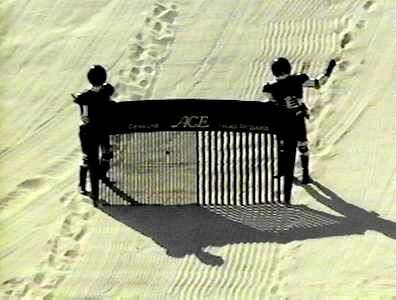
Image of the Belet sand sea at about 12 degrees South and 100 degrees West on Titan. Credit: Science.
Posted on 05/04/2006 8:02:03 PM PDT by NormsRevenge
Recent images of Titan, Saturn's largest moon, bear a striking resemblance to some of the deserts on Earth.
The pictures, captured by the Cassini spacecraft as it flew by Titan last October and released today, show sand dunes at Titan's equator much like those in the Sahara desert.
"It's bizarre," said Ralph Lorenz of University of Arizona's Lunar and Planetary Laboratory. "These images from a moon of Saturn look just like radar images of Namibia or Arabia."
On Earth, all wind is ultimately a result of heat differences produced by sunlight that warms the planet unevenly. Scientists have long assumed Titan is too far from the Sun to have solar-driven surface winds powerful enough to cause sand dunes.
But hey have more recently learned that Saturn's powerful gravity creates tidal effects in Titan's thick atmosphere. This tidal force, almost 400 times greater than that of Earth's moon tugging at our oceans, dominates near surface winds on Titan and sculpts dunes that are up to 330 feet high.
Rows of sand
The new images, revealed in the May 5 issue of the journal Science, are evidence that these dunes were built from winds that blow in one direction before switching to another and then back to the first direction and so on.
The tides cause wind to change direction as they drive winds toward the equator, Lorenz said.
This back and forth pattern cause the sand dunes to build up in long parallel lines.
These tidal winds combined with Titan's west-to-east zonal winds create dunes aligned nearly west-to-east everywhere except close to mountains, which alter wind direction.
Scientists also thought that the dark regions on Titan's equator were in fact seas of liquid ethane that trap sand. But the images reveal something different.
"If you look at the dunes, you see tidal winds might be blowing sand around the moon several times and working it into dunes at the equator," Lorenz said. "It's possible that tidal winds are carrying dark sediments from higher latitudes to the equator, forming Titan's dark belt."
Sand formation
The sand on Titan might have formed when liquid methane rained and eroded the ice bedrock.
Although it doesn't rain frequently on Titan, when it does rain it really pours. Energetic rain that triggers flash floods may be a mechanism for making sand, Lorenz said.
The sand could also have come from organic solids produced by photochemical reactions in Titan's atmosphere.
"It's exciting that the radar, which is mainly to study the surface of Titan, is telling us so much about how winds on Titan work," Lorenz said. "This will be important information for when we return to Titan in the future, perhaps with a balloon."

Man that is friggin' awesome.
Unfortunately I'm unaware of any missions at all specifically directed at Titan even in the scribbling-on-envelope stage.

Scientists don't fully understand how dunes like this arise on Mars, but they owe to a complex relationship between the sandy surface and high winds. Low gravity and the size of sand grains may play roles. These dunes are in the 106-mile-wide (170 kilometer-wide) Proctor Crater.
So does this mean there aren't seas of liquid ethane on Titan? I wonder how that affects the chances of finding any kind of life there (not that it was ever a really good bet to begin with, I'm sure).
Cassini Flies by Titan, Sees More Craters
Saturn's moon Titan continued to surprise scientists during a flyby that took Cassini into regions previously unexplored by radar. Two very noticeable circular features, possible impact craters or calderas, appear in the latest radar images taken during the flyby on April 30, 2006.
 Image right: This circular feature might be an impact crater or a cryovolcanic caldera. Image credit: NASA/JPL
Image right: This circular feature might be an impact crater or a cryovolcanic caldera. Image credit: NASA/JPL
+ Full image and caption
+ Browse version of image
The flyby targeted Xanadu, one of the most prominent features on Titan, visible even from telescopes on Earth. The origin of Xanadu is still unknown, but the radar images reveal details previously unseen, such as numerous curvy features that may indicate fluid flows. Scientists speculate that two prominent circular features are probably impact craters but they don't rule out the possibility that they might be calderas or volcanoes. Sand dunes, discovered in previous flybys, continue to crisscross Titan's surface.
Communication from the spacecraft was temporarily interrupted for nearly five hours during the data playback following the flyby. The most important science data from the flyby were protected by a contingency plan put in place in advance of the flyby. The flight team believes the outage was likely due to a galactic cosmic-ray hit on a power switch in the spacecraft communications subsystem. The anomaly resulted in the loss of some science data. However, the spacecraft is now performing normally.
This was the 14th Titan flyby for Cassini, with nine more remaining this year. The next will be May 20, 2006. During the nominal four-year mission Cassini will perform 45 Titan flybys.
The Cassini-Huygens mission is a cooperative project of NASA, the European Space Agency and the Italian Space Agency. JPL, a division of Caltech, manages the mission for NASA's Science Mission Directorate. The Cassini orbiter was designed, developed and assembled at JPL.
For images and more information, visit: http://www.nasa.gov/cassini or http://saturn.jpl.nasa.gov .
Hey! we finally found a new home for the Palestine's.... Hooray!

Radar Images Shikoku -- "Great Britain"
May 3, 2006
This image of Saturn's moon Titan from the Synthetic Aperture Radar instrument on the Cassini spacecraft shows Shikoku Facula, a region that is bright in both radar and visible wavelengths. This radar image was taken on April 30, 2006. For a visible-light image of Shikoku Facula see Naming New Lands .
A circular feature with a radar-dark interior, probably an impact crater, is seen near the top of the image and is about 35 kilometers (22 miles) in diameter. Numerous linear dark features are seen running across the image, mostly on the right-hand side. These features were seen on other radar images (see Radar Images the Margin of Xanadu and Dunes Galore) and interpreted as dune fields. Bright, ridge-like features mainly on the lower half of the image may be topographically high regions. Radar-dark, thin, sinuous features, which may be channels draining from the bright to the dark regions, are seen below the circular feature.
I understand that Saturn, being a gas planet, gives off a good bit of heat... could that have an effect similar to the tides?
I've been off line, moving, for the past week, so this is the first I've heard of this caper.
Do we know who stole them, or why? Or HOW?!?
Isn't silica common as dirt, throughout the system?
Practical joke by Alien Gonzalez?
Some life seem to thrive in a sand environment...


All that money and they can't give us color pictures?

So the "sand" is made up of water ice?
Note: this topic is from 5/04/2006. Thanks NormsRevenge.An "extra, extra" ping to the APoD list members. Update link from Red Badger.
Peer Through the Smothering Haze of Titan to Admire Its Massive Seas of Dunes

I guess the Sahara desert is a hell of a lot bigger than we thought, huh?
 ====================================================================================================================
==================================================================================================================== Gizmodo - Chris Mills 6/18/15 12:22am
Despite the obvious similarities, this isn't another satellite shot showing the Droughtpocalypse engulfing California. Instead, it’s a radar scan of methane-filled lakes on Titan, Saturn's largest moon.
The images were taken by the international Cassini mission, as part of a study into what forms depressions on Titan. Although scientists have a handle on why the lakes are filled with hydrocarbons -- turns out it rains liquid methane, thanks to the -180C climate -- the origins of the depressions are less obvious, a problem Cassini has been working to solve:
A team of scientists have turned to home for the answer and discovered that Titan's lakes are reminiscent of 'karstic' land forms seen on Earth. These are terrestrial landscapes that result from erosion of soluble rocks such as limestone and gypsum in groundwater and rainfall percolating through rocks. Over time, this leads to features including sinkholes and caves under humid climates, and salt-pans under more arid climates.
The rate of erosion depends on factors such as the chemistry of the rocks, the rainfall rate and the surface temperature. While all of these aspects clearly differ between Titan and Earth, the underlying process may be surprisingly similar.
In other words: the liquid hydrocarbons that form the lakes are dissolving Titan's surface, at a rate of around 300 feet every 50 million years.
[ESA]
GLOBAL WARMING!..........................
This article and the posts remind me of a science fiction novel I read many years ago. The premise was an ancient advanced civilization would send out robotic “factory ships” to pre-colonize worlds by mass producing everything needed for them. Houses, appliances, cities, everything. Then when the people showed up a few decades later, a whole planet with every robotic convenience was already waiting for them.
However, one of the factory ships got too close to a supernova on the way out, or something like that, and landed with a damaged central computer on Titan or on Triton, not sure which. Well, it tried to produce the items it was programmed to produce, but they were not what they were supposed to be. In the end, the “defective” robotic devices it produced became self-replicating, and evolved into mechanical life forms, eventually the most advanced of them evolved to the point of the becoming sentient. The life forms were all metallic robots, but the materials they used were all complex hydrocarbons found on the cold moon, in a reversal of our hydrocarbon life/metal instrumentalities form of life.
The humans arrived and found this “robot civilization” and had to deal with them, and there was a very interesting interplay between the two species.
Damned if I can recall the name of that book.
Disclaimer: Opinions posted on Free Republic are those of the individual posters and do not necessarily represent the opinion of Free Republic or its management. All materials posted herein are protected by copyright law and the exemption for fair use of copyrighted works.